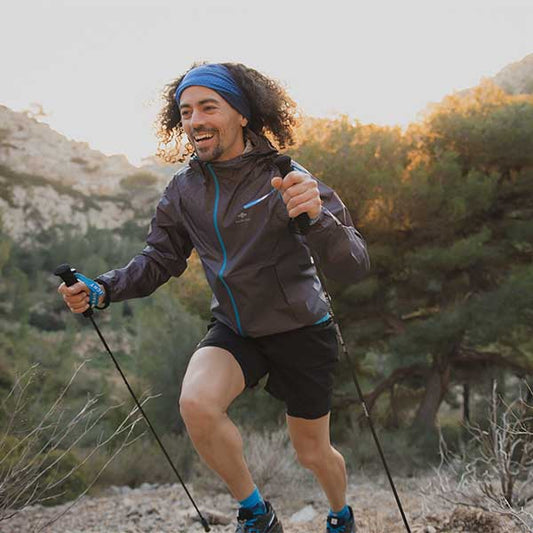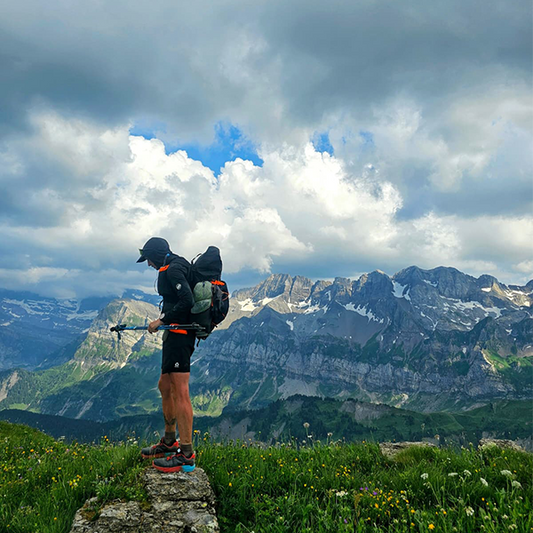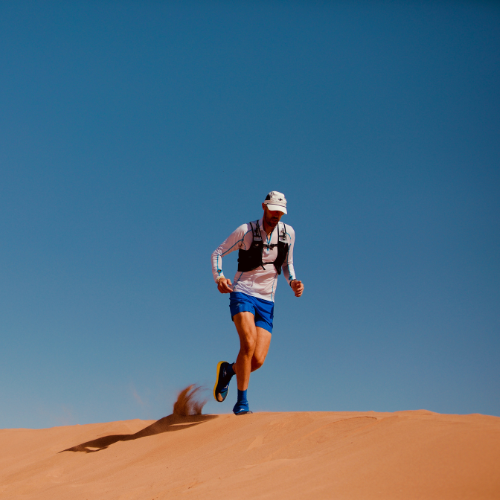In trail running, climbs are often dreaded. They require sufficient muscular strength to produce powerful support and muscular endurance to sustain the effort over time. Whether you're tackling a steep slope or managing a long, gradual ascent, these two qualities are essential. This article explores why they are crucial, how to develop them and what mistakes to avoid.
To provide you with the best possible support, we have called on our ambassador and coach specialising in physical preparation for trail athletes, Matthieu Andreux. For years he has been helping runners, both amateur and experienced, to optimise their performance and prevent injuries. A graduate in physical preparation, nutrition and reathletisation, Matthieu is renowned for his scientific and individualised approach. His aim? To help each person achieve their full potential while maintaining good physical health.
Find Matthieu on Instagram under the name matthieu_training and on https://calendly.com/matthieu-andreux/prise-de-rendez-vous-challenger

Muscular strength: the basis for propelling every stride uphill
Muscular strength, defined as the ability to generate maximum effort, is essential for climbing hills effectively. In trail running, it is expressed during steep climbs, where each stride requires a powerful push to pull yourself upwards.
Concrete benefits:
- Optimised stance: More powerful muscles generate more stable and efficient stances, reducing energy loss with each stride.
- Management of technical terrain: Increased strength enables you to negotiate obstacles (rocks, roots) while maintaining an efficient posture.
- Better running economy: A powerful runner saves energy, which is decisive over long distances.
Take the example of an experienced athlete: during an uphill test session, his increase in muscular strength (measured by the power generated with each stride) enabled him to reduce his time over a segment by 15% in just 8 weeks.
Recommended exercises :
- Heavy squats (load at 70-80% of max): Ideal for developing the quadriceps and glutes, key muscles when climbing.
- Calf raises: Reproduce the effort of a steep climb by working the power of the ankles and calves.
- Bench climbs: Strengthen the muscles while simulating the running movement.
Strength endurance: the key to lasting climbs
If raw strength allows you to produce powerful strides, strength endurance allows you to repeat this effort without exhausting yourself. On a climb, the constant repetition of muscular contractions puts the muscles to a severe test. Insufficient muscular endurance results in early fatigue and loss of efficiency.
Why it's essential:
- Delay fatigue: Strength endurance allows muscles to maintain their efficiency, even after several minutes or hours of effort.
- Prepare for long climbs: In an ultra, a climb of 30 minutes or more is common. Without strength endurance, the pace quickly collapses.
- Reduce post-exertion pain: Trained muscles tolerate prolonged exertion better, limiting soreness and injury.
Example in practice: During the UTMB, one of my athletes included 3 months' work on strength endurance with indoor circuits and repeated climbs. The result: he was able to maintain a steady pace on the climbs, saving almost 45 minutes on his final time.
Key exercises:
- Functional circuits: Link squats, lunges and bench climbs with light loads to simulate prolonged efforts.
- Uphill sessions: Alternate periods of 3-5 minutes of sustained effort with short recoveries on a moderate slope.
- Resistance training: Use elastic bands or light weights to perform long sets (15-20 repetitions).
Putting it all together in a coherent training programme
A well-structured programme integrates the development of both strength and strength endurance, alternating specific sessions for each quality. Here's a recommended approach:
- Muscular strength: One session a week focusing on heavy loads and short repetitions (4 to 6 repetitions).
- Strength endurance: Another session a week with long sets or circuits.
- Field work: Combine these qualities by incorporating specific hill sessions (steep climbs for strength, long climbs for endurance).
Natural transition between the two: ‘Working on raw strength without strength endurance is like having a powerful engine but a limited fuel reserve. To perform well on climbs, both need to be developed simultaneously.
Common mistakes and solutions
- Loading too much too quickly
Mistake: Adding heavy loads without mastering the technique or progressing.
Example: A beginner athlete who increased his squat weight by 50% in one month injured his knee due to a lack of adequate preparation.
Solution: Start with light weights, concentrate on mastering the movement, then increase by 5 to 10% every fortnight.
- Neglect recovery
Mistake: Accumulating strength sessions without giving your muscles time to regenerate.
Example: Over-training can lead to chronic muscular pain and a drop in performance.
Solution: Include days of active recovery (light cycling, walking) and quality sleep.
- Limit yourself to a single quality
Mistake: Working only on strength or only on endurance.
Example: A runner who is powerful on steep climbs but unable to hold on on long climbs quickly loses his advantage.
Solution: Alternate sessions to develop both abilities.
Developing muscular strength and strength endurance is essential if you are to perform well on climbs. These complementary qualities enable you to climb slopes efficiently while reducing fatigue and the risk of injury. With a balanced approach, proper planning and attention to detail, every runner can turn climbs into an opportunity to make a difference.
By incorporating these principles now, you can lay the foundations for lasting progress and conquer each summit with confidence.
To find out more about Matthieu or to learn more about his work, visit his website https://www.matthieu-training.fr/











